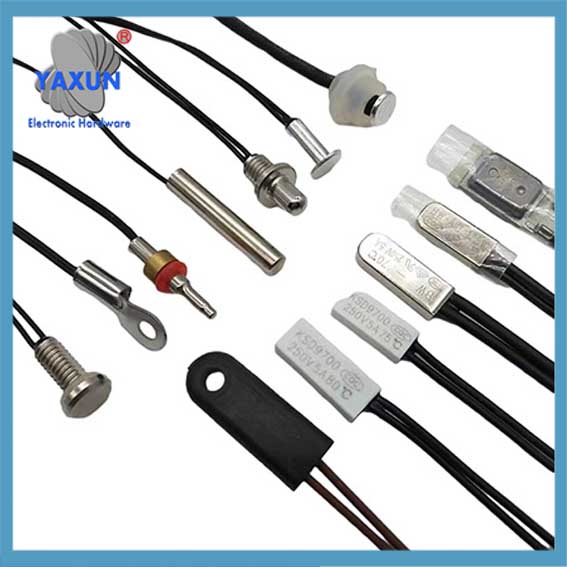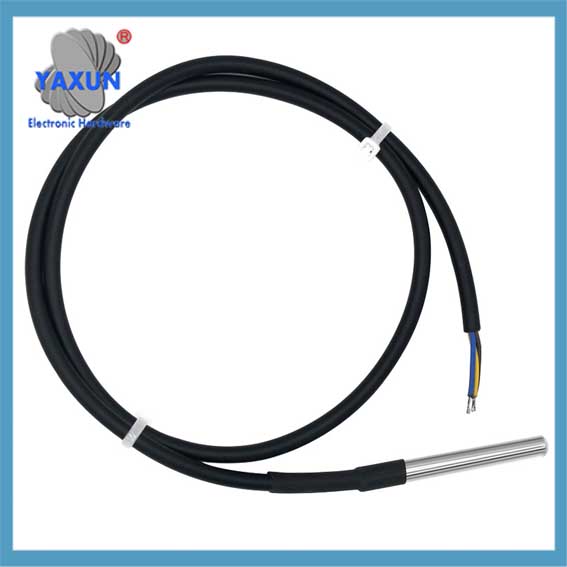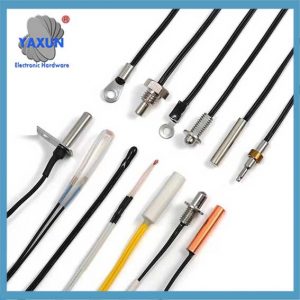Kategorije izdelkov
- Termični odklopnik 20
- Nosilec škatle z varovalkami 36
- Temperaturni senzor 67
- Termično stikalo 64
- Avtomobilska varovalka 19
- Pritrjene varovalke 7
- toplotna varovalka 32
- površinsko nameščene varovalke 12
- termistor 22
- Nosilec varovalk za PCB 27
- Kabelski snop 6
- Držala rezilnih varovalk 17
- termostat 46
- Električna varovalka 14
Oznake izdelkov
Temperaturne sonde, Vrste temperaturnih senzorjev & aplikacije
Temperaturna sonda je naprava, ki se uporablja za merjenje temperature, običajno sestavljen iz občutljivega elementa in merilnega vezja. Občutljivi element je lahko termočlen (pt100, pt1000), toplotni upor (ntc, ptc), polprevodnik (DS18B20 digitalni), itd., ki lahko pretvori temperaturne spremembe v električne signale. Potem se ojača, filtriran, pretvorjen, in jih obdeluje merilno vezje, in končno se odda električni signal, sorazmeren s temperaturo.
Temperaturne sonde in temperaturni senzorji sta dve različni napravi, in imajo svoje značilnosti in scenarije uporabe pri merjenju temperature.
Temperaturna sonda
A “Temperaturna sonda” je senzor, ki se uporablja za merjenje temperature s pretvorbo toplotne energije v merljiv električni signal, in najpogostejše vrste temperaturnih senzorjev znotraj sonde vključujejo termoelemente, Detektorji temperature odpornosti (RTD), in termistorji, vsak z različnimi lastnostmi in aplikacijami na podlagi zahtevane natančnosti, temperaturno območje, in odzivni čas, potreben za določeno situacijo.
Definition: Temperaturna sonda je naprava, ki se uporablja za merjenje temperature, običajno sestavljen iz občutljivega elementa in merilnega vezja. Občutljivi element je lahko termočlen (pt100, pt1000), toplotni upor (ntc, ptc), polprevodnik (DS18B20 digitalni), itd., ki lahko pretvori temperaturne spremembe v električne signale. Potem se ojača, filtriran, pretvorjen, in jih obdeluje merilno vezje, in končno se odda električni signal, sorazmeren s temperaturo.
Delovni načelo: Delovni načelo temperaturne sonde je uporaba odziva občutljivega elementa na temperaturne spremembe za pretvorbo temperaturnih sprememb v električne signale. Skupni občutljivi elementi vključujejo termoelemente, toplotni upori, polprevodniki, itd. Delovno načelo termoelementa je uporaba termoelektričnega učinka dveh različnih kovin ali zlitin. Ko so povezani skupaj in pri različnih temperaturah, Ustvarja se elektromotivna sila, sorazmerna s temperaturo. Delovni načelo toplotnega upora je uporaba lastnosti, da se odpornost kovinskih ali polprevodniških materialov spreminja s temperaturo. Ko se temperatura spremeni, Vrednost upora se bo prav tako spremenila. Delovni načelo polprevodnika je uporaba lastnosti, da se prevodnost polprevodniškega materiala spreminja s temperaturo. Ko se temperatura spremeni, Tudi prevodnost se bo ustrezno spremenila.
Type: Vrste temperaturnih sond vključujejo predvsem sonde termoelementov, Sonde s toplotnim uporom, polprevodniške sonde, itd. Termoelementne sonde uporabljajo termoelemente kot občutljivi elementi, in imajo značilnosti širokega obsega meritve, hitrost odziva, in visoka natančnost. Sonde s toplotnim uporom uporabljajo toplotne upor kot občutljive elemente, in imajo značilnosti visoke natančnosti meritve, dobra stabilnost, in močna sposobnost proti interferenci. Polprevodniške sonde uporabljajo polprevodnike kot občutljivi elementi, in imajo značilnosti majhne velikosti, lahka teža, in nizko porabo energije.
Application Fields: Temperaturne sonde se pogosto uporabljajo v industriji, Znanstvene raziskave, zdravstvena oskrba, varstvo okolja in druga polja. Na primer merjenje temperature in nadzor v kemikaliji, nafta, metalurgija, elektrika, farmacevtska, Hrana in druge panoge.
Kabel temperaturnega senzorja DS18B20 s sondo
Ožičenje: Rdeča(VCC), Rumena(Podatki), Črna(GND)
Široko temperaturno območje -55 ℃ ~ +125 ℃
Napajanje: 3.0V ~ 5.5V
Nasveti: Uporaba 4,7K upora med podatki in VCC bo testiranje sonde olajšalo.
Termočlen:
funkcija: Ustvari napetostno razliko, ki temelji na temperaturi na stičišču dveh različnih kovinskih žic.
Proti: Široko temperaturno območje (-200° C do 1750 ° C.), razmeroma poceni, hiter odzivni čas.
Točno: Nižja natančnost v primerjavi z drugimi senzorji, Za pretvorbo napetosti v temperaturo zahteva kalibracijske tabele.
Aplikacije: Visokotemperaturne aplikacije, kot so peči, spremljanje motorja, industrijski procesi.
Termistor:
Uporaba temperaturnih sond:
Industrijski procesi: Temperatura spremljanja v proizvodnih procesih, kot so pečice, reaktorji, in ekstruderji.
HVAC sistemi: Uravnavanje sobne temperature v stavbah s spremljanjem temperature zraka.
Varnost hrane: Spremljanje temperature hrane med kuhanjem in skladiščenjem, da se zagotovi varnost hrane.
Medicinske pripomočke: Merjenje telesne temperature pri bolnikih s sondami, vstavljenimi v telo.
Avtomobilska industrija: Spremljanje temperature hladilne tekočine motorja in temperature kabine.
Znanstvene raziskave: Natančne meritve temperature v poskusih.
Senzor temperature
Definition: Temperaturni senzor je naprava, ki lahko pretvori temperaturne spremembe v električne signale. Običajno je sestavljen iz občutljivega elementa in vezja za obdelavo signala. Občutljivi element je lahko termočlen, toplotni upor, polprevodnik, itd. Tokokrog za obdelavo signala je lahko analogno vezje, digitalno vezje, itd., ki skupaj dokončajo pridobitev, obdelava in izhod temperaturnih signalov.
Delovni načelo: Delovno načelo temperaturnega senzorja je podobno kot pri temperaturni sondi. Uporablja tudi odziv občutljivega elementa na spremembo temperature za pretvorbo temperaturne spremembe v električni signal. Vendar, Temperaturni senzor ima običajno bolj zapleteno vezje za obdelavo signala, ki lahko izvaja bolj napredno obdelavo na temperaturnem signalu, kot je digitalna pretvorba, shranjevanje podatkov, komunikacija, itd.
Type: Vrste temperaturnih senzorjev vključujejo predvsem analogne temperaturne senzorje, Senzorji digitalne temperature, in inteligentni temperaturni senzorji. Analogni temperaturni senzorji izhodi Analogni signali, ki jih je treba pretvoriti v digitalne signale z analognimi in digitalnimi pretvorniki. Digitalni temperaturni senzorji neposredno oddajajo digitalne signale, in imajo značilnosti močne sposobnosti proti interferenci, visoka natančnost, in enostavna integracija. Inteligentni temperaturni senzorji imajo funkcije, kot je samodiagnoza, samokalibracija, in komunikacija, in lahko uresničimo daljinsko spremljanje in nadzor.
Feature: Temperaturni senzor ima značilnosti visoke natančnosti meritve, dobra stabilnost, Močna sposobnost proti interferenci, in enostavna integracija. Različne vrste temperaturnih senzorjev imajo različne značilnosti, na primer analogni temperaturni senzorji potrebujejo analogne do-digitalne pretvornike, Digitalni temperaturni senzorji neposredno oddajajo digitalne signale, In inteligentni temperaturni senzorji imajo funkcije, kot je samodiagnoza, samokalibracija, in komunikacija.
Application Fields: Temperaturni senzorji se pogosto uporabljajo v pametnem domu, pameten nosljiv, medicinska oprema, Industrijska avtomatizacija, spremljanje okolja in druga polja, kot so klimatske naprave, hladilniki, pralni stroji, termometri, sfigmomanometri, Industrijski nadzor, itd.
Kako izbrati?
Pri izbiri temperaturne sonde ali temperaturnega senzorja, Upoštevati je treba naslednje dejavnike:
Okolje za uporabo: Razmislite, ali ima izmerjeno okolje posebne pogoje, kot je jedkost, visoka temperatura, visok tlak, itd., tako da izberete ustrezne materiale in raven zaščite.
Podjetje Measurement: Izberite ustrezen senzor glede na območje temperature, ki jo je treba izmeriti, da se zagotovi, da lahko senzor natančno izmeri znotraj potrebnega območja.
Zahteve Accuracy: Izberite senzor z ustrezno natančnostjo glede na zahteve natančnosti aplikacije za merjenje temperature.
Cost proračun: Izberite stroškovno učinkovit senzor glede na proračunske omejitve.
Kako uporabiti?
Pri uporabi temperaturne sonde ali temperaturnega senzorja, Opozoriti je treba naslednje zadeve:
Installation: Pravilno ga namestite v skladu z navodili za namestitev senzorja, da zagotovite, da je senzor v dobrem stiku z objektom, ki ga je treba izmeriti, in se izognete napakam merjenja, ki jih povzroči nepravilna namestitev.
Wiring: Pravilno priključite signalno črto in daljnovo linijo senzorja, da zagotovite stabilnost in natančnost prenosa signala.
Kalibracija: Senzor redno kalibrirajte, da zagotovite, da njegova natančnost merjenja ustreza zahtevam uporabe.
Matriatenja: Redno čistite in vzdržujte senzorja, da se izognete prahu, umazanija, itd. vpliva na merilno delovanje senzorja.
Senzor temperaturne sonde je eden od pomembnih izdelkov našega podjetja YXAUN. Osredotočamo se na področja inteligentne proizvodnje in industrijske avtomatizacije, in zagotoviti vrsto visoko natančnosti in stabilne opreme za merjenje in krmiljenje, vključno s senzorji temperaturne sonde. Naši senzorji temperaturne sonde se pogosto uporabljajo v industrijski proizvodnji, Okoljsko spremljanje, upravljanje z energijo in druge panoge z visoko natančnostjo, stabilnost in prilagodljivost zapletenim okoljem. Če imate posebne potrebe ali vprašanja o naših senzorjih temperaturne sonde, Prosimo, da se posvetujete. V celoti vam bomo zagotovili profesionalne odgovore in storitve. Kakšen vidik senzorja temperaturne sonde želite vedeti?
Kako izbrati ustrezen senzor za temperaturo?
Pri izbiri senzorja temperature sonde, Razmislite o območju merjenja temperature, zahteve glede natančnosti, Hitrost odziva in namestitveno okolje. Na primer, Termoelementi ali platinasta odpornost lahko izberete za industrijska okolja, PT100 za visoko natančnost, in termoelementi za hiter odziv.
Kontaktirajte nas
Čakam na vašo e-pošto, vam bomo odgovorili v roku 12 ure z dragocenimi informacijami, ki jih potrebujete.
 English
English العربية
العربية Български
Български 粤语
粤语 中文(简体)
中文(简体) 中文(漢字)
中文(漢字) Nederlands
Nederlands Suomi
Suomi Français
Français Deutsch
Deutsch Ελληνικά
Ελληνικά Magyar
Magyar Italiano
Italiano 日本語
日本語 한국어
한국어 Polski
Polski Português
Português Română
Română Русский
Русский Slovenščina
Slovenščina Español
Español Svenska
Svenska ภาษาไทย
ภาษาไทย Türkçe
Türkçe Tiếng Việt
Tiếng Việt












